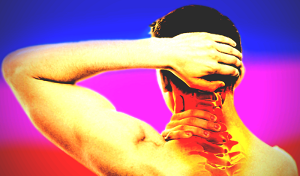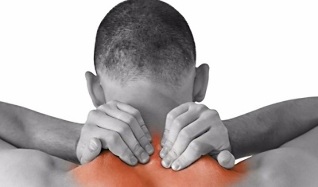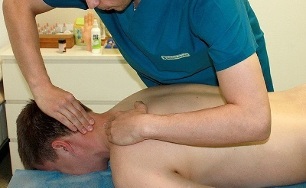Cervical osteochondrosis is a common disease that is accompanied by degenerative and dystrophic changes in the spine. The symptoms of the disease in men and women are the same. Treatment is prescribed by a doctor depending on the severity of the lesions and the patient's condition.
Symptoms of osteochondrosis in men
The main symptom of cervical osteochondrosis is pain. There are a number of additional signs that will help determine the presence of degenerative lesions of the spine in the cervical spine.
Pain occurs against the background of disorders in the peripheral area. This is a result of the adverse effects on the nerve roots and junctions that connect tissues, intervertebral discs and muscles. With cervical osteochondrosis, men experience periodic or persistent pain. In the morning, the patient may feel boring pain deep in the neck.
Important!Unpleasant sensations occur when turning the head, coughing and sneezing.
Because of the strong tension in the muscles, a man cannot breathe deeply. The pain can radiate to the occipital part of the head. This suggests a lesion of the occipital nerve.

When palpating the upper cervical vertebrae, a man can feel a painful lump. When a compensation of the nerve roots occurs, discomfort can radiate to the shoulders and arms.
Cervical osteochondrosis is characterized by degenerative processes in the intervertebral discs.
A deterioration in blood flow to the nerve nodes leads to the following symptoms:
- burning pain in the back of the head;
- numbness of the hands at night;
- swelling of the hands;
- irregular heart rate;
- grinds and crackles when you turn your head.
Vascular signs occur when the brain stem is affected. Cervical osteochondrosis disrupts normal blood flow in the vertebral arteries. Against the background of such pathological changes, neurotic failures appear:
- insomnia;
- unreasonable irritability;
- shaky gait;
- dizziness;
- fast heart rate;
- excessive sweating;
- impaired memory.
In some cases, the performance of the visual device deteriorates. The danger of osteochondrosis is that it provokes the development of the following syndromes:
- stenosis. This is a narrowing of the spinal canal when the vessels in the brain are compressed by herniated discs. The upper and lower limbs begin to numb.
- Reflex irritant. This syndrome is accompanied by burning pain in the back of the head.
- Root. In this pathology, the nerve roots are compressed by the intervertebral disc. The pain is painful, burning and throbbing.
In most cases, the symptoms of osteochondrosis in men are almost the same as in women. When the first pain attacks appear, the patient does not always suspect that it is cervical osteochondrosis. Timely diagnosis will help avoid complications.
Diagnosis of cervical osteochondrosis
X-rays are taken to diagnose the disease. This will help ensure that there is no spinal injury. However, this research method does not provide a way to see osteophytes. For this, more modern diagnostic methods are used.

Execute assigned:
- computed tomography;
- magnetic tomography;
- Ultrasound examination of neck vessels.
Computed tomography makes a series of x-rays that show the volume of the cervical vertebrae. This level of detail makes it possible to assess the type of nerve compression, the height of the intervertebral discs and the structure of the osteophytes.
Magnetic resonance imaging is one of the most informative diagnostic methods. You can use it to assess the condition of bone structures. During an MRI, the doctor can determine the presence of an inguinal hernia.
Duplex vascular scanning is used when the doctor suspects a bleeding disorder in the vertebral arteries.
Treatment of male osteochondrosis
The treatment is selected depending on the degree of damage and the general well-being of the man. In most cases, medication and physical therapy are recommended.
HELP.Conservative therapy aims to relieve pain and muscle spasms.
Physiotherapy activates regeneration processes in the cartilage tissue. Such procedures can be part of a comprehensive treatment or as a stand-alone method.
The following procedures are assigned:
- Electrotherapy.The impact on the affected areas of the spine is caused by an electric current. This manipulation activates blood circulation. Contraindications are the presence of a pacemaker or metal parts in the patient's body.
- Magnetotherapy.With this method, a constant magnetic field is exposed. One procedure takes 20 minutes.
- Laser therapy.Helium-neon lasers are used. They improve bioelectrical processes in the tissues of the nervous system. It has anti-inflammatory, analgesic and wound healing effects. The exposure time in one area is a maximum of 2 minutes, the entire process takes about 14 minutes.
- shock wave therapy.This type of exposure is rarely used as its effectiveness is very controversial. The impact occurs through sound waves. They help to promote the metabolism and activate the microcirculation in the blood.
- Balneotherapy.The treatment is carried out with mineral water and therapeutic mud. All useful substances penetrate the skin and act on receptors and nerve endings.
To restore mobility to the affected area, gymnastics exercises should be performed. They strengthen the muscle corset and make the ligaments more flexible. The first training sessions should take place under the supervision of a trainer, as it is not the number of exercises that is important, but their technique.
Important!Surgical intervention is indicated when medical treatment and physical therapy have not produced the desired results.

This is known as a cervical discectomy. The doctor immobilizes the affected segment and removes the hernia, which puts pressure on the spinal nerve. Over time, the eddies grow together. 3-5 days after the operation, the patient is brought to the ambulance.
The duration of the rehabilitation phase is approx. 3 months. The exact time of rehabilitation depends on the implant and the occupational activity of the operated patient.
In any case, it is worth starting the treatment of cervical osteochondrosis with a visit to the doctor. Self-treatment can make the disease worse and lead to surgery.
drugs for treatment
Medicines for osteochondrosis should only be taken as directed by a doctor. He creates a therapeutic scheme and selects the optimal dosage.
The following groups of medicines are prescribed:
- analgesics;
- antispasmodics;
- anti-inflammatory drugs;
- vasodilators;
- chondroprotectors.
HELP.Active ingredients not only relieve cramps, but also reduce the sensitivity of nerve endings.
The doctor may prescribe the use of nonsteroidal anti-inflammatory drugs. These drugs relieve pain and reduce inflammation.
It is recommended to use drugs to reduce blood viscosity as a vasodilator. They improve the microcirculation in the blood. Taking such drugs promotes speedy recovery after treatment for cervical osteochondrosis.
The effect of chondroprotectors aims to activate regeneration processes in the injured cartilage.

An incorrectly selected treatment can lead to the formation of a herniated disc. With cervical osteochondrosis, high blood pressure often occurs. If necessary, the doctor prescribes drugs to relieve the symptoms of such a pathological condition.
For drug treatment to be as effective as possible, it must be combined with therapeutic exercises and physiotherapeutic procedures.
Try not to jerk your neck after a chiropractic session. The muscles after the procedure are maximally relaxed and you can reduce the positive effect of the session.
Diet for osteochondrosis
With osteochondrosis, a man should pay special attention to his diet. It needs to be balanced as the body needs to receive adequate amounts of vitamins and nutrients.
The following foods should be included in the diet:
- vegetables and herbs;
- berries and fruits;
- milk products and fermented milk products;
- high protein foods;
- foods that contain gelatin and collagen.
Plant-based foods are rich in vitamins and fiber. They have a low energy value, which helps maintain normal weight. Parsley, cauliflower, beets and broccoli are particularly beneficial.
Patients with osteochondrosis are advised to include sea buckthorn in their diet. You can make jelly from fruits and berries. Fermented dairy products are high in calcium, vitamin D, and phosphorus. These vitamins and nutrients strengthen bones and cartilage tissue.
The following products should be included in the daily menu:
- fermented baked milk;
- cheese without preservatives;
- yogurt;
- curdled milk.
It is important that dairy products and fermented milk products are natural, with no colorings and other harmful additives. Protein is important for the formation of bone and cartilage tissue. Most of it is found in eggs, milk, whole grains, and brewer's yeast.
Fish and seafood will benefit from this. They contain fatty and polyunsaturated acids that are necessary for the normal regeneration of the body. Collagen is found in jelly, aspic fish, and aspic. It promotes the synthesis of cartilage tissue.
HELP.It is recommended to replace cold-pressed olive oil with simple vegetable oil. It is important to maintain the water balance.
Use only filtered or bottled water.
Most men see a doctor when osteochondrosis is at an advanced stage. There are a number of symptoms that indicate the development of a pathological condition. Timely diagnosis and treatment will help avoid operations and complications.





































